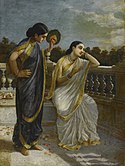Rádža Ravi Varma
| Rádža Ravi Varma | |
|---|---|
 | |
| Narození | 29. dubna 1848 Kilimanoor |
| Úmrtí | 2. října 1906 (ve věku 58 let) Attingal |
| Alma mater | University College Trivandrum |
| Povolání | malíř a tvůrce |
| Děti | Rama Varma |
| Příbuzní | C. Raja Raja Varma (sourozenec) |
| Podpis | |
| Některá data mohou pocházet z datové položky. | |
Rádža Ravi Varma (29. dubna 1848, Kilimanoor – 2. října 1906, Attingal) byl indický malíř. Proslavil se ilustracemi k moderním vydáním eposů Mahábhárata a Ramajána.
Život
Byl členem vládnoucího rodu Kilimanúr v knížectví Travankúr (dnes indický stát Kérala). Jeho matka Umajamba Thampurattí byla spisovatelka, její dnes nejznámější knihu Parvátí Swajamvaram nechal Ravi Varma vydat po její smrti. Jeho velkým podporovatelem byl především maharádža Ajiljáma Thirúnala z Travankúru, samotný vládce jeho rodného knížectví, s nímž byl Ravi spřízněn.
Kreslit se učil nejprve v Madurai a posléze u Rámy Svámího Naidua. Ten ho zasvětil do techniky akvarelu. Techniku olejomalby se pak doučil u nizozemského malíře Theodora Jensona. To mu otevřelo cestu na západ – jako jednomu z prvních indických moderních umělců. V roce 1873 získal první cenu na výstavě ve Vídni. V roce 1893 získal dvě zlaté medaile na světové výstavě v Chicagu. Teprve mezinárodní úspěch mu zajistil, že byl doceněn i doma. V roce 1904 mu místokrál Cutzon udělil zlatou medaili za přínos umění. Na počátku 20. století pak jeho obrazy silně ovlivnily celou indickou kulturu. Mít jejich reprodukce doma patřilo k projevům vlastenectví střední třídy (hinduistické). Také Ravi Varmovy obrazy žen, které maloval především podle modelů jihoindických drávidských dívek, nově definovaly ideál krásy (zejm. Kálí, Lakšmí, Sarasvatí, Dáma z Maháráštry, Dívka s ovocem ad.) Jeho dílo je stále silně přítomno v indické pop-kultuře.
Od roku 2001 stát Kérala uděluje uměleckou cenu pojmenovanou po něm – Rádža Ravi Varma Puraskaram.[1]
Galerie
Karthikeya
Sarasvatí
Ráma
Damayanti
Slečny v měsíčním světle
Šantanu a Satyavati
Simhaka a Sairandhri
Jatayův boj s Ravanem
Bavící se dívka
Nebe hudebníků
Dáma z Maháráštry
Cikáni
Dívka s ovocem
Portrét dívky
Odkazy
Reference
Externí odkazy
 Obrázky, zvuky či videa k tématu Rádža Ravi Varma na Wikimedia Commons
Obrázky, zvuky či videa k tématu Rádža Ravi Varma na Wikimedia Commons - Biografie na Famous People.com
Média použitá na této stránce
King Shantanu falling in love with Matsyagandhi (Satyavati. King Shantanu is captivated by Satyavati or Matsyagandha and wants to marry her. Their liaison later set the stage for the epic Mahabharata. Satyavati, brought up by a fish chieftain, agrees to marry Shantanu on the condition that their children would inherit the throne, thereby denying Devavrata, Shantanu's son his rightful place. Shantanu doesn't agree to it initially but after his son, Devavrata takes the bachelor-hood vow and comes to be addressed as Bhishma, agrees to the conditions, Shantanu marries her and fathers two children -- Chitrangada and Vichitravirya.)
Hindu deity Karttikeya or Murugan with his consorts on his Vahana peacock.
Varuna the Lord of ocean, pacifying Sri Rama, angered at the intransigence of the sea to give way to enter Lanka.
Portrait of an Indian woman holding a fan as she leans on a window frame overlooking a landscape with shrubbery, distant hills and the setting sun. She wears a pale blue sari, with heavy bangles and other jewellery. Painted in the Western academic tradition.
Draupadi in the guise of Syrendri taken to forest by Virata's wife Simhika, who plans to kill her.
Princess Damayanti and a maid in the Moonlight.
A poor gypsy family sitting by the street.
Portrait of a lady from Maharashtra, holding a plate full of fruits.
Indian women dressed in regional attire playing a variety of musical instruments popular in different parts of the country.
A photograph of Ravi Varma himself, by Bhawani Ram, 1890's
Goddess Saraswati, Goddess of knowledge. This print from the Ravi Varma Press derived from a painting by Raja Ravi Varma follows the iconographic description of Saraswati as found in the 50th chapter of the Agni Purana. She is described in the Agni Purana as being attired in white and playing the Veena with two arms and holding an aksha-mala (a string of pearls) and a pustaka (book) in the other hands.
Damayanti, the princess of Vidarbha Kingdom, talking with a divine swan, who tells her about Nala, the king of Nishada. This story has been narrated in many Hindu scriptures, including the Mahabharat and the Nishada Charita.





























